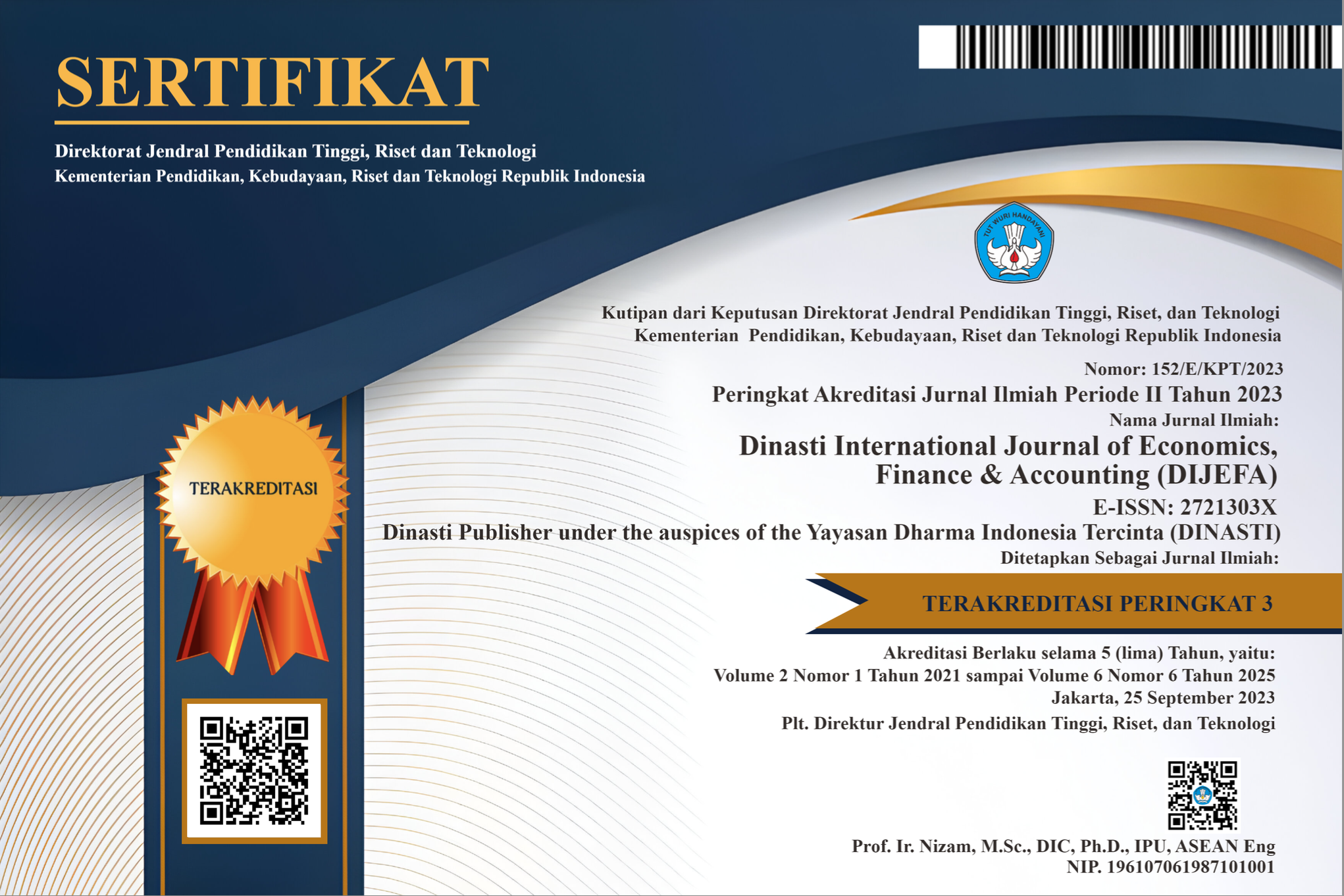Analysis of Green Brand Image on Green Brand Equity With Green Trust, Green Satisfaction, And Green Perceived Value As Mediation
DOI:
https://doi.org/10.38035/dijefa.v5i6.3817Keywords:
Green Brand Image, Green Brand Equity, Green Perceived Value, Green Satisfaction, Green TrustAbstract
People are starting to recognize that using green products daily is a crucial step in solving the global environmental crisis. The concept behind green marketing is to develop green brands and green products. This study investigates the influence of green brand image on green brand equity. In addition, it is also to examine the impact of green brand image on green brand equity mediated by green trust, green satisfaction, and green perceived value. It is a quantitative study. A self-administered survey was used to collect data. The sampling method uses non-probability sampling techniques. The sampling technique used is purposive sampling with 196 respondents. In this study, the Partial Least Square (PLS) data analysis technique was used. The outer model analysis was measured using validity tests, and the structural model is an analytical step to test a hypothesis. The results of this study show that Green Brand Image directly affects Green Brand Equity. Green Brand Image affects Green Brand Equity by partially mediating Green Trust, Green Satisfaction, and Green Perceived Value.
References
Ansary, A., & Nik Hashim, N. M. H. (2018). Brand image and equity: the mediating role of brand equity drivers and moderating effects of product type and word of mouth. Review of Managerial Science, 12(4), 969–1002. https://doi.org/10.1007/s11846-017-0235-2
Bekk, M., Spörrle, M., Hedjasie, R., & Kerschreiter, R. (2016). Greening the competitive advantage: antecedents and consequences of green brand equity. Quality and Quantity. https://doi.org/10.1007/s11135-015-0232-y
Chen, Y. S. (2010). The drivers of green brand equity: Green brand image, green satisfaction, and green trust. Journal of Business Ethics. https://doi.org/10.1007/s10551-009-022
Chen, Y. S. (2013). Towards green loyalty: Driving from green perceived value, green satisfaction, and green trust. Sustainable Development, 21(5), 294–308. https://doi.org/10.1002/sd.500
Cooper, D. R., & Schindler, P. S. (2014). Business Research Methods 12th Edition. In Business Research Methods.
Dangaiso, P. (2024). Leveraging green brand equity for organic food brands: the multifaceted role of green satisfaction. Cogent Business and Management, 11(1). https://doi.org/10.1080/23311975.2024.2321791
de Sio, S., Zamagni, A., Casu, G., & Gremigni, P. (2022). Green Trust as a Mediator in the Relationship between Green Advertising Skepticism, Environmental Knowledge, and Intention to Buy Green Food. International Journal of Environmental Research and Public Health, 19(24). https://doi.org/10.3390/ijerph192416757
Delafrooz, N., & Goli, A. (2015a). The factors affecting the green brand equity of electronic products: Green marketing. Cogent Business and Management, 2(1). https://doi.org/10.1080/23311975.2015.1079351
Diva, M. A. (2020). THE ANTECEDENTS OF GREEN BRAND EQUITY OF GREEN COSMETICS. Managament Insight: Jurnal Ilmiah Manajemen, 15(2), 156–172. https://doi.org/10.33369/insight.15.2.156-172
Esmaeili, A., Sepahvand, A., Rostamzadeh, R., Joksiene, I., & Antucheviciene, J. (2017). Efekt integrace ekologických a tradi?ních konstrukcí zna?ky z pohledu ekologicky mín?ného nákupu zákazník?. E a M: Ekonomie a Management, 20(3), 219–237. https://doi.org/10.15240/tul/001/2017-3-015
Górska-Warsewicz, H., D?bski, M., Fabuš, M., & Ková?, M. (2021). Green brand equity—empirical experience from a systematic literature review. In Sustainability (Switzerland) (Vol. 13, Issue 20). MDPI. https://doi.org/10.3390/su132011130
Ha, M. T. (2021). Optimizing Green Brand Equity: The Integrated Branding and Behavioral Perspectives. SAGE Open, 11(3). https://doi.org/10.1177/21582440211036087
Hair, Jr, J. F. (2015). Essentials of Business Research Methods. In Essentials of Business Research Methods. https://doi.org/10.4324/9781315704562
Huang, Y. C., Yang, M., & Wang, Y. C. (2014). Effects of the Green Brand on Green Purchase Intention. Marketing Intelligence and Planning. https://doi.org/10.1108/MIP-10-2012-0105
Jannah, N., Bahri, M. I., Kismawadi, E. R., & Handriana, T. (2024). The Effect of Green Brand Image and Green Satisfaction on Green Brand Equity Mediated Green Trust Outpatients. Quality - Access to Success, 25(198), 381–390. https://doi.org/10.47750/QAS/25.198.40
Kang, S., & Hur, W. M. (2012). Investigating the Antecedents of Green Brand Equity: A Sustainable Development Perspective. Corporate Social Responsibility and Environmental Management. https://doi.org/10.1002/csr.281
Khan, M. S., Hassan, N. ul, & Aslam, R. A. (2023). Green Brand Image and Green Brand Equity: Testing Mediating Role of Green Customer Satisfaction for Banks in Pakistan. Pakistan Journal of Humanities and Social Sciences, 11(2). https://doi.org/10.52131/pjhss.2023.1102.0561
Kotler, P., & Keller, K. L. (2016). Marketing Management 15/e. In Prentice Hall. https://doi.org/10.1080/08911760903022556
Malik, M. (2015). Value-Enhancing Capabilities of CSR: A Brief Review of Contemporary Literature. Journal of Business Ethics. https://doi.org/10.1007/s10551-014-2051-9
Mourad, M., & Ahmed, Y. S. E. (2012). Perception of green brand in an emerging innovative market. European Journal of Innovation Management. https://doi.org/10.1108/14601061211272402
Ng, P. F., Butt, M. M., Khong, K. W., & Ong, F. S. (2014). Antecedents of Green Brand Equity: An Integrated Approach. Journal of Business Ethics, 121(2), 203–215. https://doi.org/10.1007/s10551-013-1689-z
Downloads
Published
How to Cite
Issue
Section
License
Copyright (c) 2025 M.A. Diva Vilaningrum Wadyatenti, Fransisca Desiana Pranatasari

This work is licensed under a Creative Commons Attribution 4.0 International License.
Authors who publish their manuscripts in this journal agree to the following conditions:
- The copyright on each article belongs to the author(s).
- The author acknowledges that the Dinasti International Journal of Economics, Finance & Accounting (DIJEFA) has the right to be the first to publish with a Creative Commons Attribution 4.0 International license (Attribution 4.0 International (CC BY 4.0).
- Authors can submit articles separately, arrange for the non-exclusive distribution of manuscripts that have been published in this journal into other versions (e.g., sent to the author's institutional repository, publication into books, etc.), by acknowledging that the manuscript has been published for the first time in the Dinasti International Journal of Economics, Finance & Accounting (DIJEFA).


























































